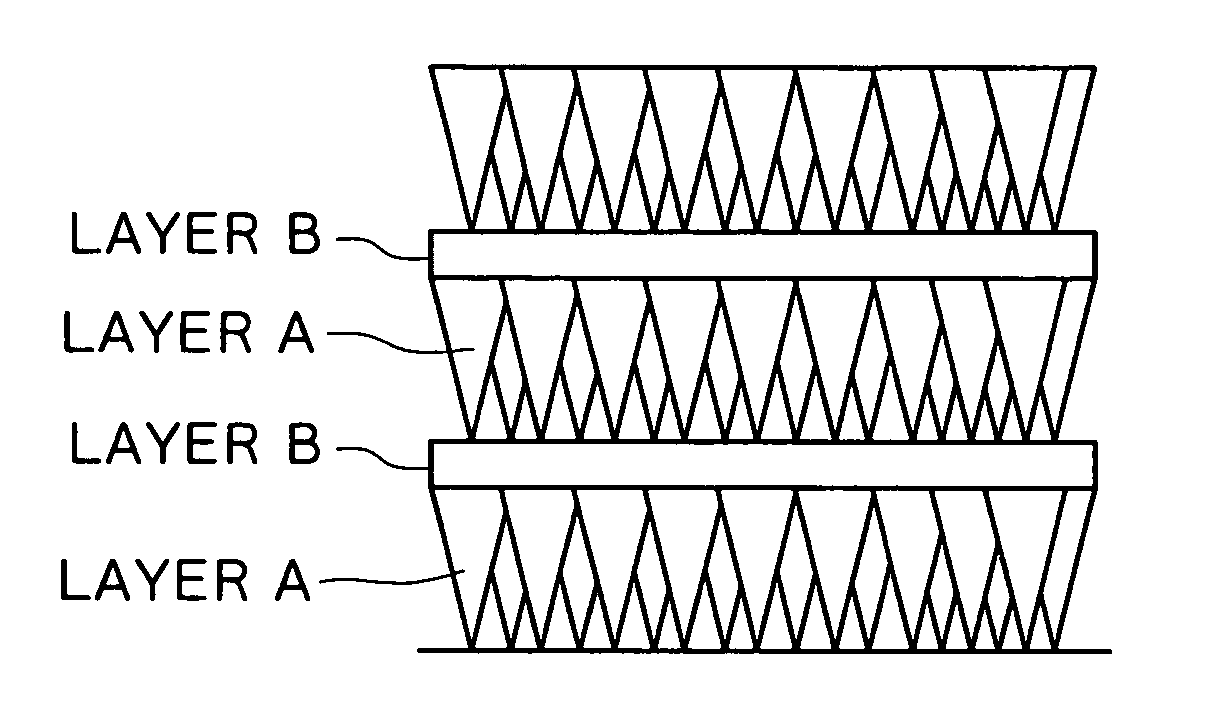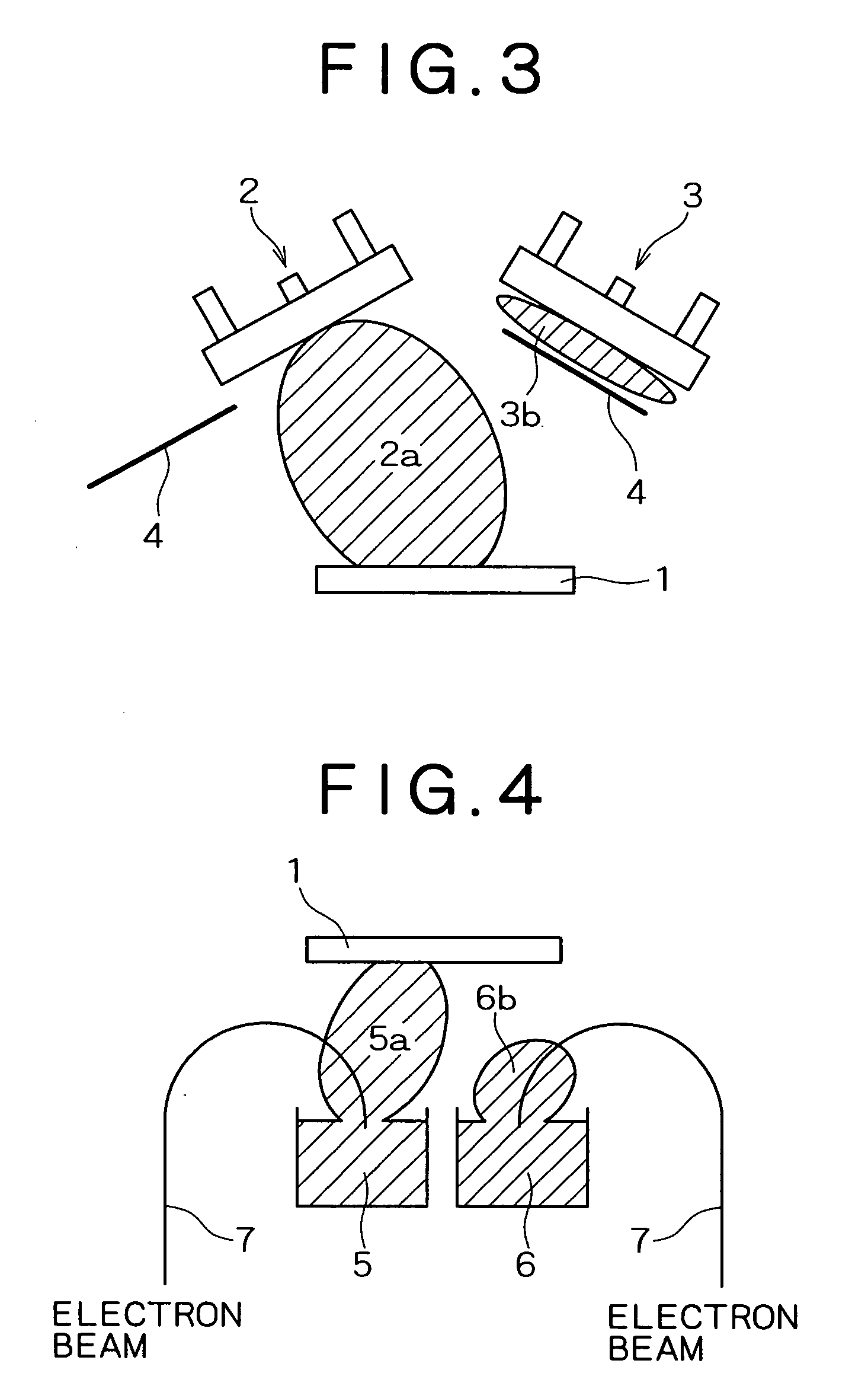Hard laminated film, method of manufacturing the same and film-forming device
a technology of laminated film and manufacturing method, which is applied in the direction of instruments, superimposed coating process, natural mineral layered products, etc., can solve the problems of difficult to precisely control the thickness of the thin film layer which is formed, difficult to adjust the film-forming rate, and difficult to manufacture samples having exactly the right particle size, etc., to achieve enhanced film-forming performance, high-efficiency gas ionization, and the effect of intensifying ion irradiation to the substra
- Summary
- Abstract
- Description
- Claims
- Application Information
AI Technical Summary
Benefits of technology
Problems solved by technology
Method used
Image
Examples
first embodiment
[0120] (Composition of Hard Film Layer A)
[0121] The composition formula of the hard film layer A which is the principal phase of the hard film of this invention, requires the selection of a substance having a rock-salt crystal structure, high hardness and wear resistance. This hard film having a rock-salt crystal structure may for example be a nitride, carbonitride or carbide having a cubic rock-salt structure containing Ti, Cr, Al or V such as TiN, CrN or TiAlN which are widely used in cutting tools and wear-resistant sliding parts. In addition, it may also be a compound of one or more elements selected from among 4A, 5A, 6A and Al or Si, with one or more elements selected from among B, C, N. These compounds all have a cubic rock-salt structure, high hardness and superior wear resistance. If a minute amount of 10% or less (0.1 or less in terms of atomic ratio) of oxygen is added to layer A within a range in which the rock-salt crystal structure of the hard film layer A is maintain...
second embodiment
[0128] The Inventors discovered that, by forming the layer A having a chemical composition corresponding to the following formula (1) and the layer B having a chemical composition corresponding to the following formula (2) so that the aforesaid deposition requirements are satisfied, a hard film having superior wear resistance and lubricity was obtained, and thereby arrived at the present invention. [0129] Layer A: Cr (BaCbN1-a-b-cOc)e
0≦a≦0.15, 0≦b≦0.3, 0≦c≦0.1, 0.2≦e≦1.1 (1) [0130] Layer B: B1-x-tCsNt
0≦s≦0.25, (1−s−t) / t≦1.5 (2)
[0131] The reason for specifying the composition of Layer A and Layer B as mentioned above, will now be described in detail.
[0132] [Composition of Layer A]
[0133] First, the reason why layer A is a Cr (B, C, N, O) film containing B, C, N, O in the proportions shown in the aforesaid formula (1), is as follows.
[0134] Layer A has chromium nitride (CrN, Cr2N) of high hardness as its main component so that the film retains its wear resistance. The hardness ca...
third embodiment
[0154] (Composition of Layer A)
[0155] The composition of layer A, which is the main phase of the hard laminated film according to the third embodiment, should have high oxidizing properties in applications wherein sliding parts such as cutting tools reach a high temperature. The layer A must also have the basic properties required of the hard film, such as high hardness and wear resistance.
[0156] For this reason, the composition of layer A may be represented by:
[0157] Formula 1: (Ti1-x-yAlxMy)(BaCbN1-a-b-cOc) [wherein, x, y, a, b, c are respectively atomic ratios, 0.4≦x≦0.8, 0≦y≦0.6, 0≦a≦0.15, 0≦b≦0.3, 0≦c≦0.1, and M is one or metal elements selected from among 4A, 5A, 6A, Si.
[0158] Among the compositions of layer A represented by Formula 1, (Ti1-x-yAlxMy)(BaCbN1-a-b-cOc) [wherein x, y, a, b, c are respectively atomic ratios 0.5≦x≦0.8, 0.05≦y≦0.6, 0≦a≦0.15, 0≦b≦0.3, 0≦c≦0.1, and M is one or metal elements selected from among Cr, V, Si], is preferred.
[0159] In the aforesaid Form...
PUM
| Property | Measurement | Unit |
|---|---|---|
| thickness | aaaaa | aaaaa |
| thickness | aaaaa | aaaaa |
| θ- | aaaaa | aaaaa |
Abstract
Description
Claims
Application Information
 Login to View More
Login to View More - R&D
- Intellectual Property
- Life Sciences
- Materials
- Tech Scout
- Unparalleled Data Quality
- Higher Quality Content
- 60% Fewer Hallucinations
Browse by: Latest US Patents, China's latest patents, Technical Efficacy Thesaurus, Application Domain, Technology Topic, Popular Technical Reports.
© 2025 PatSnap. All rights reserved.Legal|Privacy policy|Modern Slavery Act Transparency Statement|Sitemap|About US| Contact US: help@patsnap.com



